Tesco PLC: Strategy and Global Competitive Environment Analysis Report
VerifiedAdded on 2020/04/21
|24
|4847
|210
Report
AI Summary
This report provides a comprehensive analysis of Tesco PLC's business and corporate strategies within the context of the global competitive environment. It begins with an overview of the retail industry's current strategies and how Tesco positions itself within this landscape. The report then delves into Tesco's strategic approach, evaluating its use of frameworks like the Ansoff matrix and generic strategies, including cost leadership and differentiation. Key aspects such as market penetration, product development, and diversification are examined, alongside an analysis of Tesco's 4Ps (Product, Price, Place, Promotion). The report considers the company's business penetration strategies, particularly its international expansion and localization efforts. Finally, the report offers recommendations for Tesco to maintain and enhance its competitive advantage in the dynamic retail sector. The analysis draws on various sources to provide a well-rounded understanding of Tesco's strategic choices and their impact on its global presence.
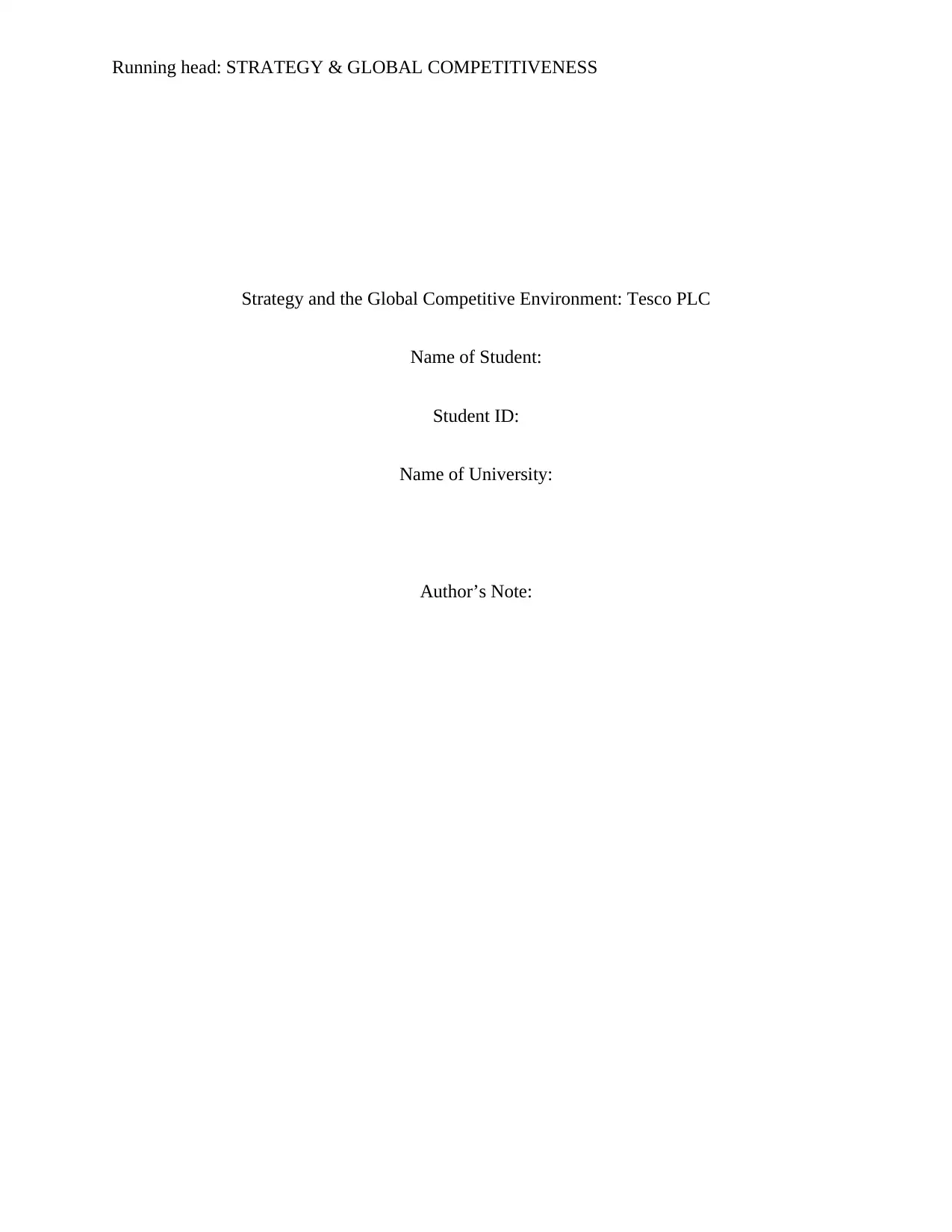
Running head: STRATEGY & GLOBAL COMPETITIVENESS
Strategy and the Global Competitive Environment: Tesco PLC
Name of Student:
Student ID:
Name of University:
Author’s Note:
Strategy and the Global Competitive Environment: Tesco PLC
Name of Student:
Student ID:
Name of University:
Author’s Note:
Paraphrase This Document
Need a fresh take? Get an instant paraphrase of this document with our AI Paraphraser
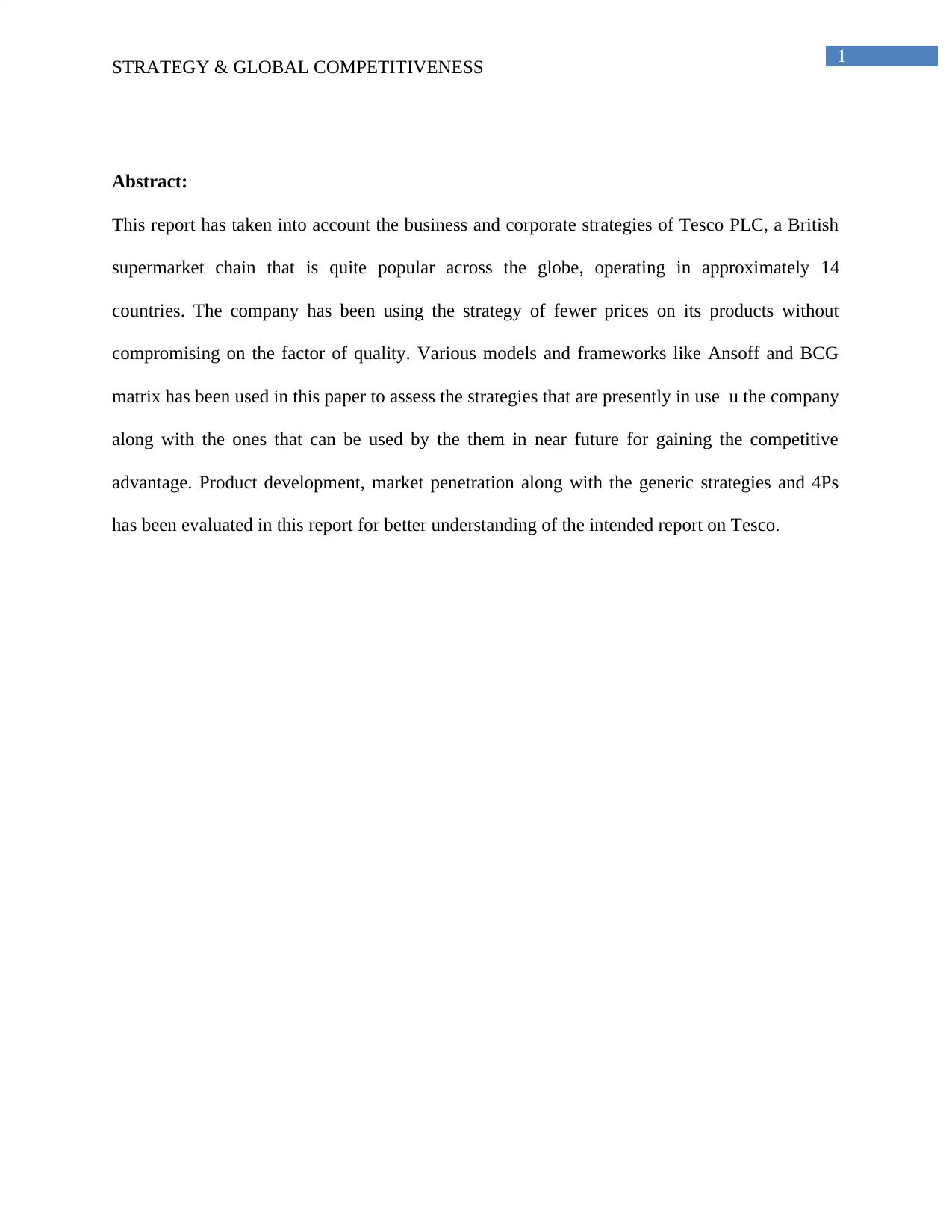
1
STRATEGY & GLOBAL COMPETITIVENESS
Abstract:
This report has taken into account the business and corporate strategies of Tesco PLC, a British
supermarket chain that is quite popular across the globe, operating in approximately 14
countries. The company has been using the strategy of fewer prices on its products without
compromising on the factor of quality. Various models and frameworks like Ansoff and BCG
matrix has been used in this paper to assess the strategies that are presently in use u the company
along with the ones that can be used by the them in near future for gaining the competitive
advantage. Product development, market penetration along with the generic strategies and 4Ps
has been evaluated in this report for better understanding of the intended report on Tesco.
STRATEGY & GLOBAL COMPETITIVENESS
Abstract:
This report has taken into account the business and corporate strategies of Tesco PLC, a British
supermarket chain that is quite popular across the globe, operating in approximately 14
countries. The company has been using the strategy of fewer prices on its products without
compromising on the factor of quality. Various models and frameworks like Ansoff and BCG
matrix has been used in this paper to assess the strategies that are presently in use u the company
along with the ones that can be used by the them in near future for gaining the competitive
advantage. Product development, market penetration along with the generic strategies and 4Ps
has been evaluated in this report for better understanding of the intended report on Tesco.
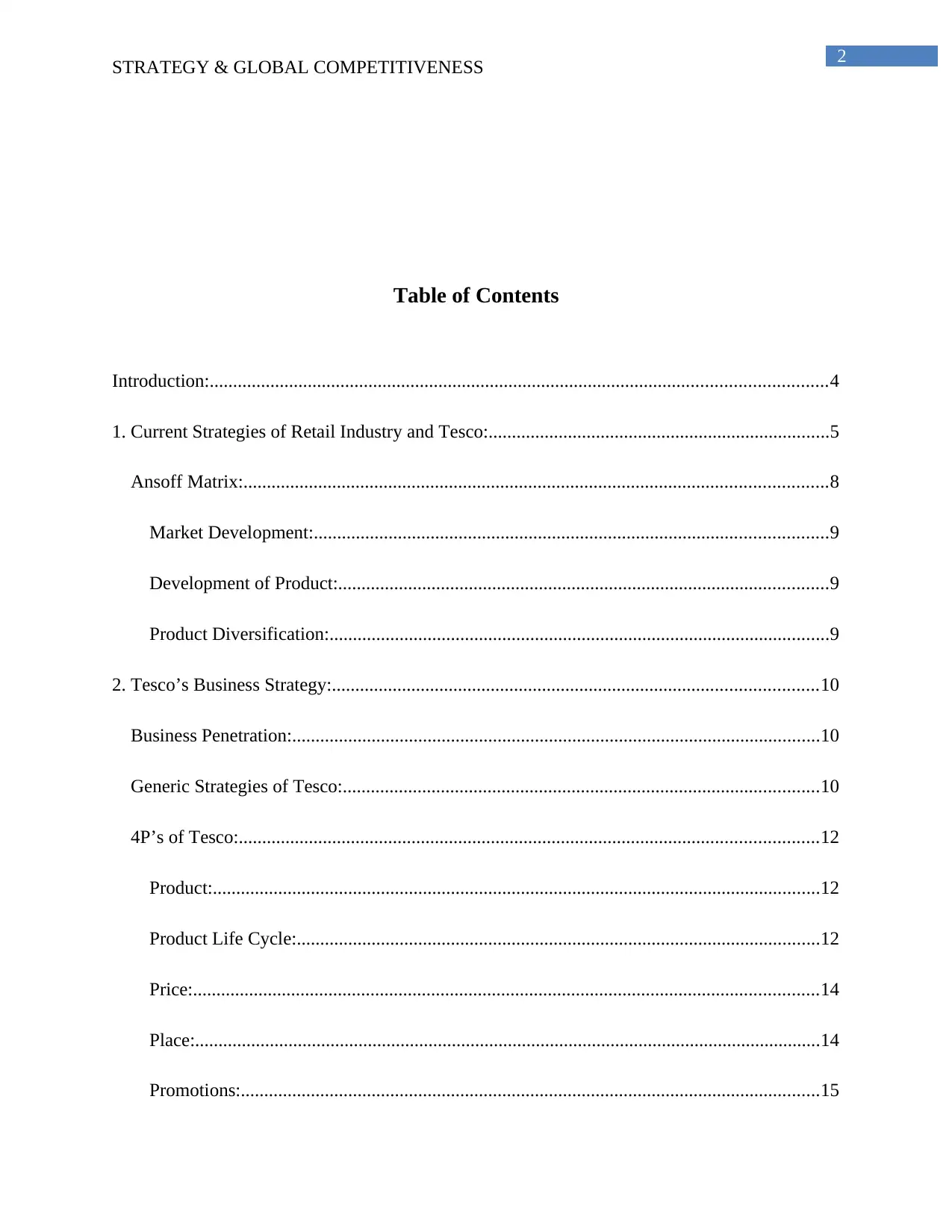
2
STRATEGY & GLOBAL COMPETITIVENESS
Table of Contents
Introduction:....................................................................................................................................4
1. Current Strategies of Retail Industry and Tesco:.........................................................................5
Ansoff Matrix:.............................................................................................................................8
Market Development:..............................................................................................................9
Development of Product:.........................................................................................................9
Product Diversification:...........................................................................................................9
2. Tesco’s Business Strategy:........................................................................................................10
Business Penetration:.................................................................................................................10
Generic Strategies of Tesco:......................................................................................................10
4P’s of Tesco:............................................................................................................................12
Product:..................................................................................................................................12
Product Life Cycle:................................................................................................................12
Price:......................................................................................................................................14
Place:......................................................................................................................................14
Promotions:............................................................................................................................15
STRATEGY & GLOBAL COMPETITIVENESS
Table of Contents
Introduction:....................................................................................................................................4
1. Current Strategies of Retail Industry and Tesco:.........................................................................5
Ansoff Matrix:.............................................................................................................................8
Market Development:..............................................................................................................9
Development of Product:.........................................................................................................9
Product Diversification:...........................................................................................................9
2. Tesco’s Business Strategy:........................................................................................................10
Business Penetration:.................................................................................................................10
Generic Strategies of Tesco:......................................................................................................10
4P’s of Tesco:............................................................................................................................12
Product:..................................................................................................................................12
Product Life Cycle:................................................................................................................12
Price:......................................................................................................................................14
Place:......................................................................................................................................14
Promotions:............................................................................................................................15
⊘ This is a preview!⊘
Do you want full access?
Subscribe today to unlock all pages.

Trusted by 1+ million students worldwide
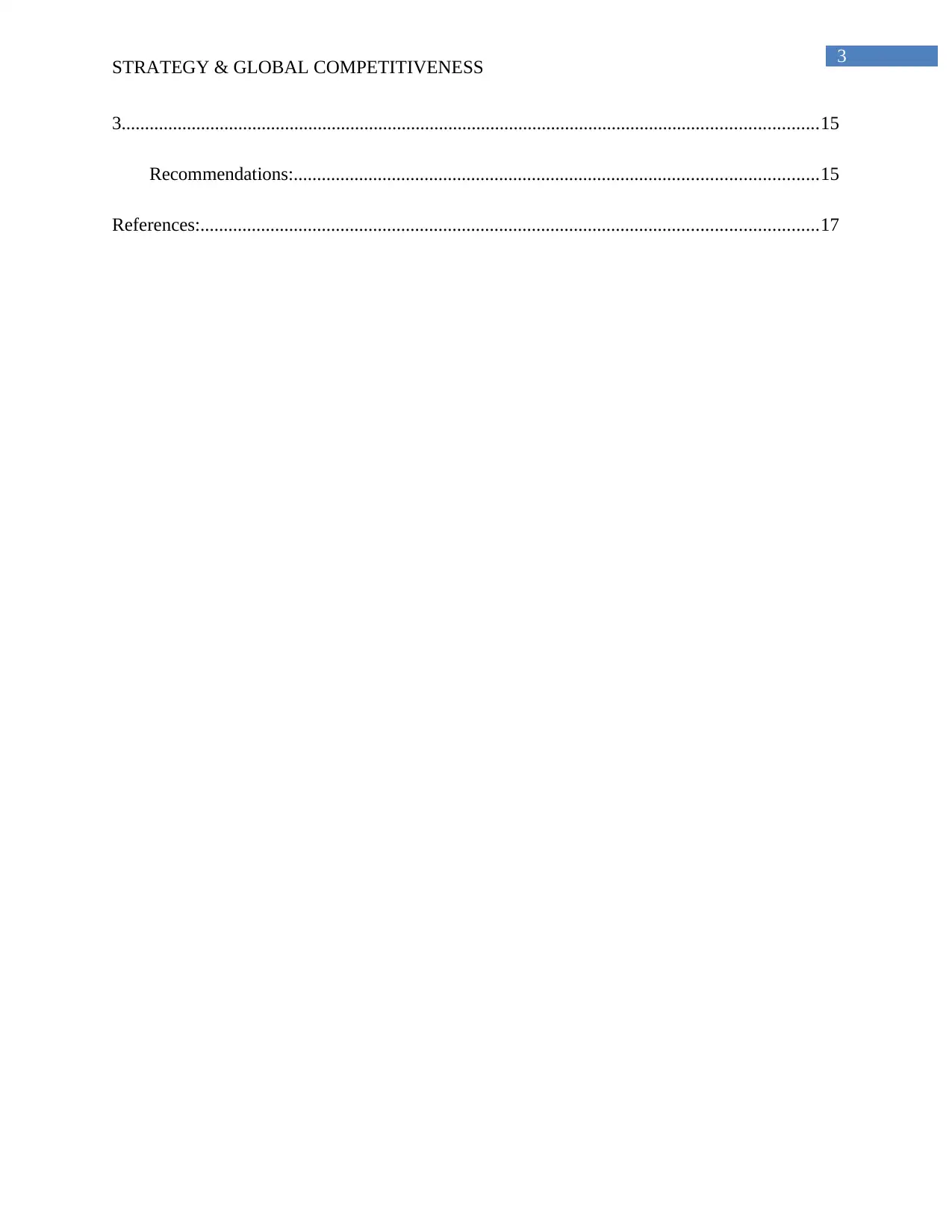
3
STRATEGY & GLOBAL COMPETITIVENESS
3.....................................................................................................................................................15
Recommendations:................................................................................................................15
References:....................................................................................................................................17
STRATEGY & GLOBAL COMPETITIVENESS
3.....................................................................................................................................................15
Recommendations:................................................................................................................15
References:....................................................................................................................................17
Paraphrase This Document
Need a fresh take? Get an instant paraphrase of this document with our AI Paraphraser
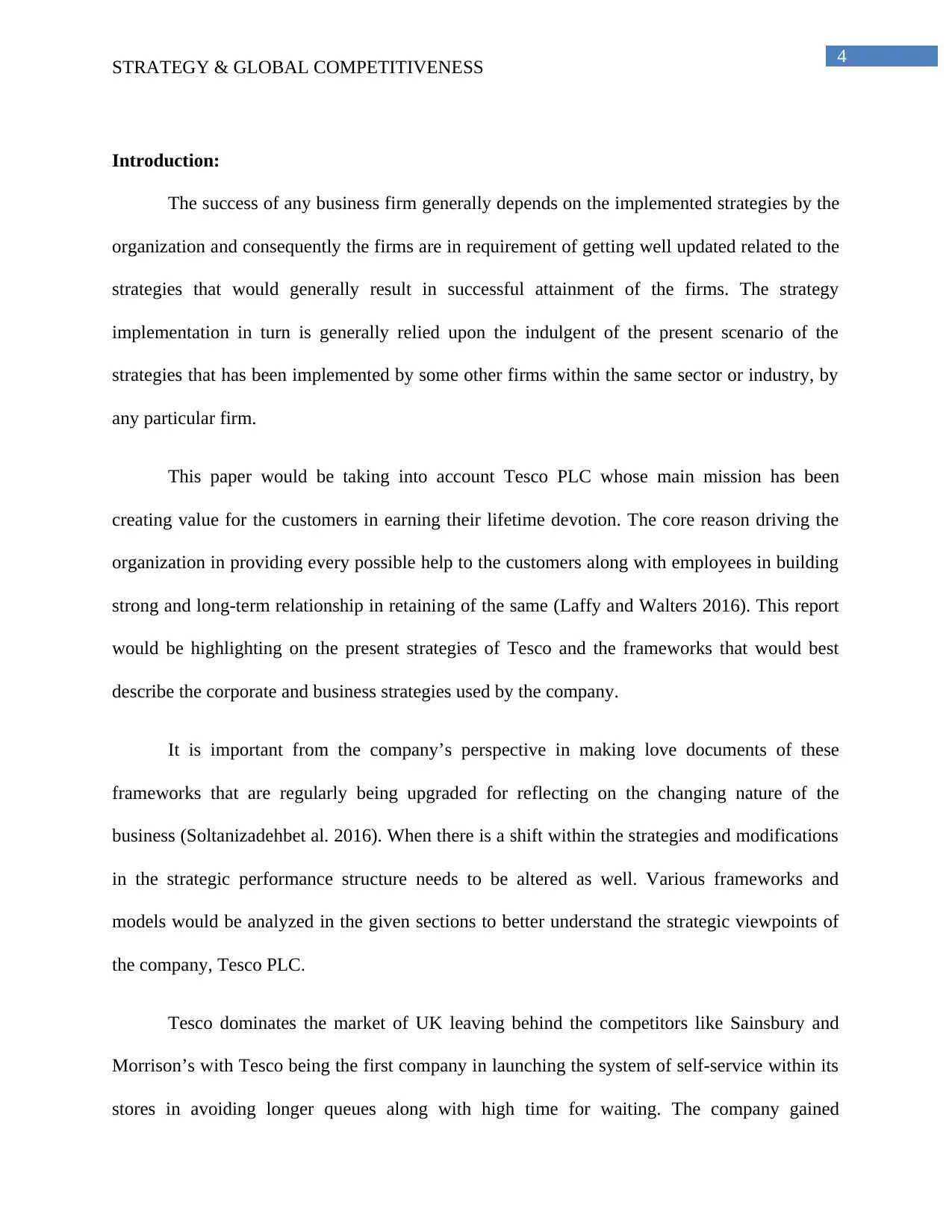
4
STRATEGY & GLOBAL COMPETITIVENESS
Introduction:
The success of any business firm generally depends on the implemented strategies by the
organization and consequently the firms are in requirement of getting well updated related to the
strategies that would generally result in successful attainment of the firms. The strategy
implementation in turn is generally relied upon the indulgent of the present scenario of the
strategies that has been implemented by some other firms within the same sector or industry, by
any particular firm.
This paper would be taking into account Tesco PLC whose main mission has been
creating value for the customers in earning their lifetime devotion. The core reason driving the
organization in providing every possible help to the customers along with employees in building
strong and long-term relationship in retaining of the same (Laffy and Walters 2016). This report
would be highlighting on the present strategies of Tesco and the frameworks that would best
describe the corporate and business strategies used by the company.
It is important from the company’s perspective in making love documents of these
frameworks that are regularly being upgraded for reflecting on the changing nature of the
business (Soltanizadehbet al. 2016). When there is a shift within the strategies and modifications
in the strategic performance structure needs to be altered as well. Various frameworks and
models would be analyzed in the given sections to better understand the strategic viewpoints of
the company, Tesco PLC.
Tesco dominates the market of UK leaving behind the competitors like Sainsbury and
Morrison’s with Tesco being the first company in launching the system of self-service within its
stores in avoiding longer queues along with high time for waiting. The company gained
STRATEGY & GLOBAL COMPETITIVENESS
Introduction:
The success of any business firm generally depends on the implemented strategies by the
organization and consequently the firms are in requirement of getting well updated related to the
strategies that would generally result in successful attainment of the firms. The strategy
implementation in turn is generally relied upon the indulgent of the present scenario of the
strategies that has been implemented by some other firms within the same sector or industry, by
any particular firm.
This paper would be taking into account Tesco PLC whose main mission has been
creating value for the customers in earning their lifetime devotion. The core reason driving the
organization in providing every possible help to the customers along with employees in building
strong and long-term relationship in retaining of the same (Laffy and Walters 2016). This report
would be highlighting on the present strategies of Tesco and the frameworks that would best
describe the corporate and business strategies used by the company.
It is important from the company’s perspective in making love documents of these
frameworks that are regularly being upgraded for reflecting on the changing nature of the
business (Soltanizadehbet al. 2016). When there is a shift within the strategies and modifications
in the strategic performance structure needs to be altered as well. Various frameworks and
models would be analyzed in the given sections to better understand the strategic viewpoints of
the company, Tesco PLC.
Tesco dominates the market of UK leaving behind the competitors like Sainsbury and
Morrison’s with Tesco being the first company in launching the system of self-service within its
stores in avoiding longer queues along with high time for waiting. The company gained
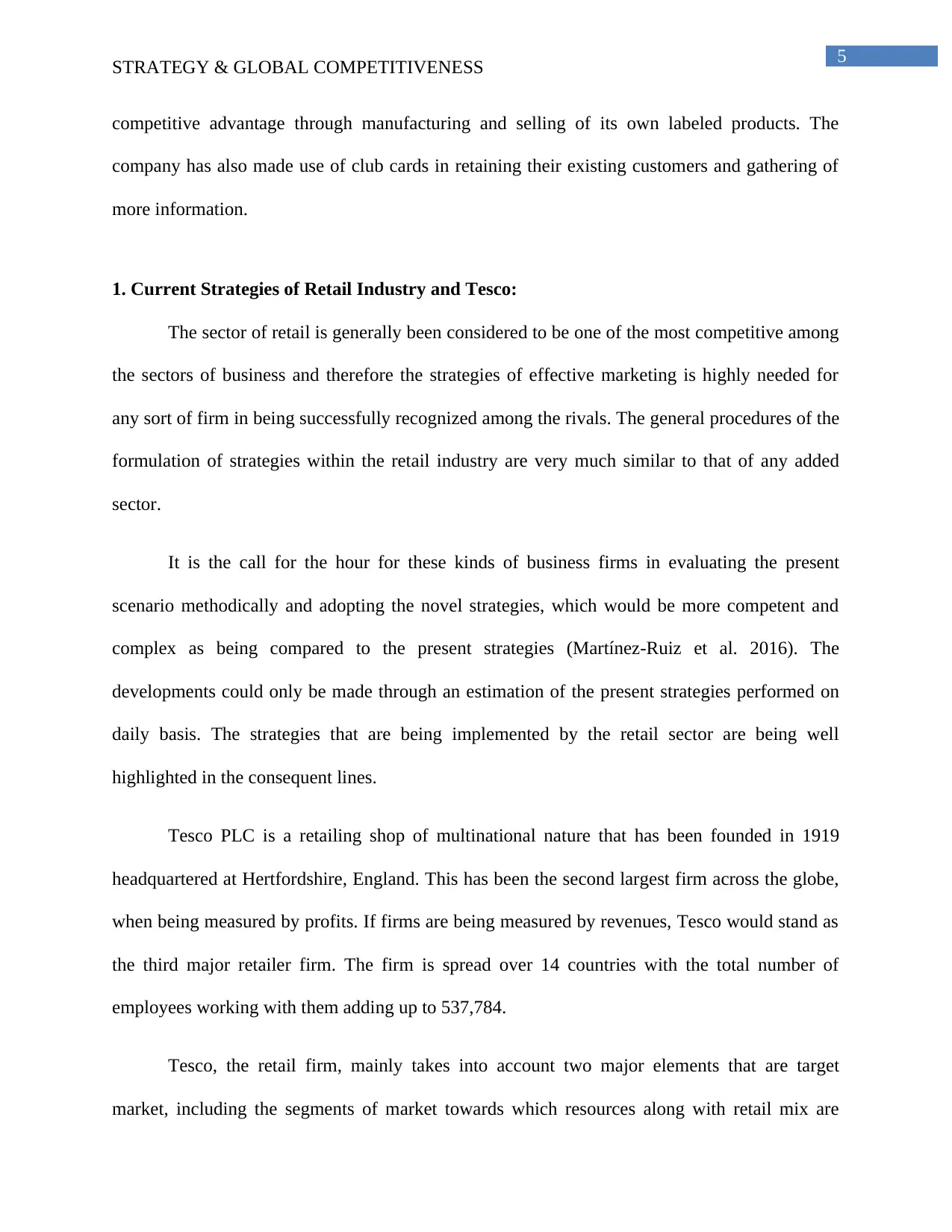
5
STRATEGY & GLOBAL COMPETITIVENESS
competitive advantage through manufacturing and selling of its own labeled products. The
company has also made use of club cards in retaining their existing customers and gathering of
more information.
1. Current Strategies of Retail Industry and Tesco:
The sector of retail is generally been considered to be one of the most competitive among
the sectors of business and therefore the strategies of effective marketing is highly needed for
any sort of firm in being successfully recognized among the rivals. The general procedures of the
formulation of strategies within the retail industry are very much similar to that of any added
sector.
It is the call for the hour for these kinds of business firms in evaluating the present
scenario methodically and adopting the novel strategies, which would be more competent and
complex as being compared to the present strategies (Martínez-Ruiz et al. 2016). The
developments could only be made through an estimation of the present strategies performed on
daily basis. The strategies that are being implemented by the retail sector are being well
highlighted in the consequent lines.
Tesco PLC is a retailing shop of multinational nature that has been founded in 1919
headquartered at Hertfordshire, England. This has been the second largest firm across the globe,
when being measured by profits. If firms are being measured by revenues, Tesco would stand as
the third major retailer firm. The firm is spread over 14 countries with the total number of
employees working with them adding up to 537,784.
Tesco, the retail firm, mainly takes into account two major elements that are target
market, including the segments of market towards which resources along with retail mix are
STRATEGY & GLOBAL COMPETITIVENESS
competitive advantage through manufacturing and selling of its own labeled products. The
company has also made use of club cards in retaining their existing customers and gathering of
more information.
1. Current Strategies of Retail Industry and Tesco:
The sector of retail is generally been considered to be one of the most competitive among
the sectors of business and therefore the strategies of effective marketing is highly needed for
any sort of firm in being successfully recognized among the rivals. The general procedures of the
formulation of strategies within the retail industry are very much similar to that of any added
sector.
It is the call for the hour for these kinds of business firms in evaluating the present
scenario methodically and adopting the novel strategies, which would be more competent and
complex as being compared to the present strategies (Martínez-Ruiz et al. 2016). The
developments could only be made through an estimation of the present strategies performed on
daily basis. The strategies that are being implemented by the retail sector are being well
highlighted in the consequent lines.
Tesco PLC is a retailing shop of multinational nature that has been founded in 1919
headquartered at Hertfordshire, England. This has been the second largest firm across the globe,
when being measured by profits. If firms are being measured by revenues, Tesco would stand as
the third major retailer firm. The firm is spread over 14 countries with the total number of
employees working with them adding up to 537,784.
Tesco, the retail firm, mainly takes into account two major elements that are target
market, including the segments of market towards which resources along with retail mix are
⊘ This is a preview!⊘
Do you want full access?
Subscribe today to unlock all pages.

Trusted by 1+ million students worldwide
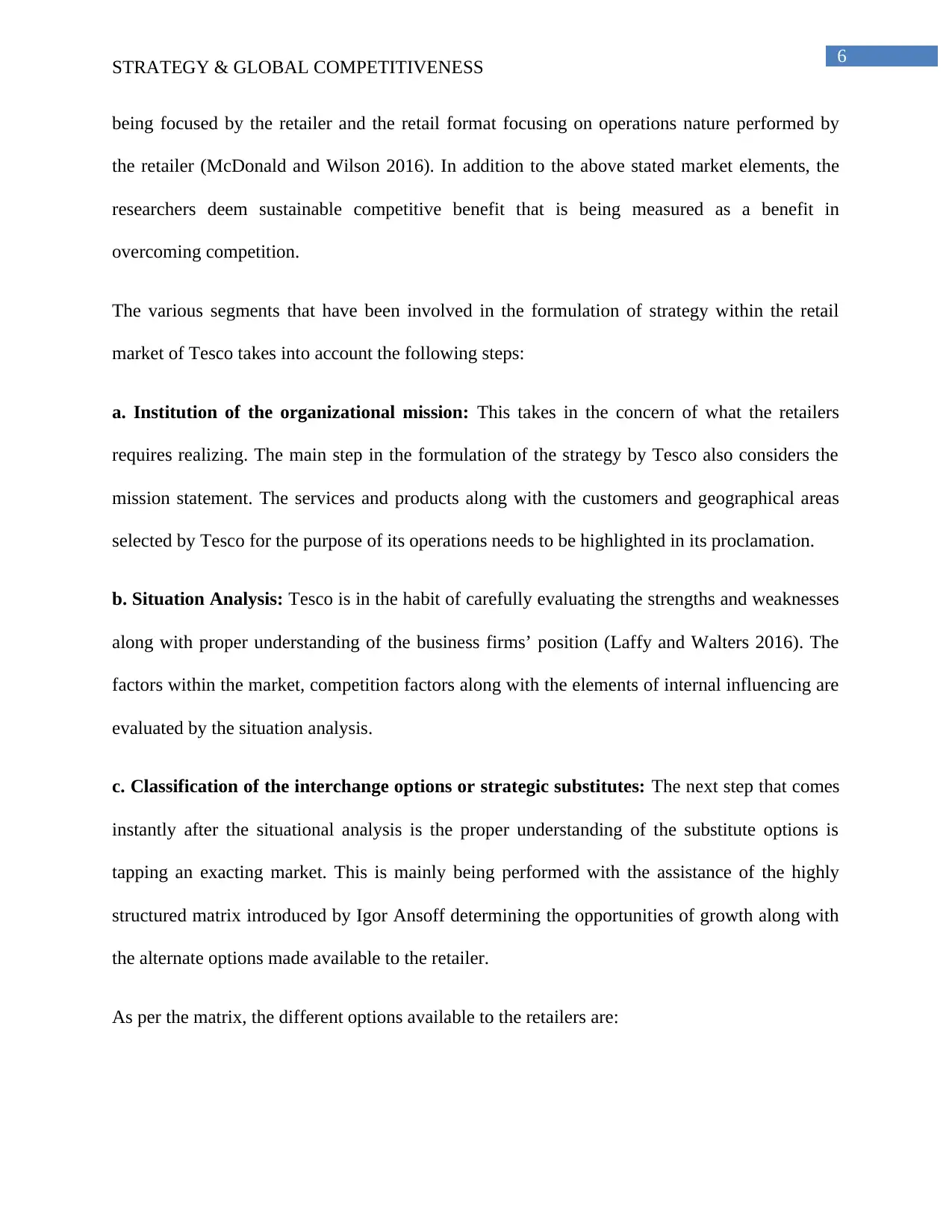
6
STRATEGY & GLOBAL COMPETITIVENESS
being focused by the retailer and the retail format focusing on operations nature performed by
the retailer (McDonald and Wilson 2016). In addition to the above stated market elements, the
researchers deem sustainable competitive benefit that is being measured as a benefit in
overcoming competition.
The various segments that have been involved in the formulation of strategy within the retail
market of Tesco takes into account the following steps:
a. Institution of the organizational mission: This takes in the concern of what the retailers
requires realizing. The main step in the formulation of the strategy by Tesco also considers the
mission statement. The services and products along with the customers and geographical areas
selected by Tesco for the purpose of its operations needs to be highlighted in its proclamation.
b. Situation Analysis: Tesco is in the habit of carefully evaluating the strengths and weaknesses
along with proper understanding of the business firms’ position (Laffy and Walters 2016). The
factors within the market, competition factors along with the elements of internal influencing are
evaluated by the situation analysis.
c. Classification of the interchange options or strategic substitutes: The next step that comes
instantly after the situational analysis is the proper understanding of the substitute options is
tapping an exacting market. This is mainly being performed with the assistance of the highly
structured matrix introduced by Igor Ansoff determining the opportunities of growth along with
the alternate options made available to the retailer.
As per the matrix, the different options available to the retailers are:
STRATEGY & GLOBAL COMPETITIVENESS
being focused by the retailer and the retail format focusing on operations nature performed by
the retailer (McDonald and Wilson 2016). In addition to the above stated market elements, the
researchers deem sustainable competitive benefit that is being measured as a benefit in
overcoming competition.
The various segments that have been involved in the formulation of strategy within the retail
market of Tesco takes into account the following steps:
a. Institution of the organizational mission: This takes in the concern of what the retailers
requires realizing. The main step in the formulation of the strategy by Tesco also considers the
mission statement. The services and products along with the customers and geographical areas
selected by Tesco for the purpose of its operations needs to be highlighted in its proclamation.
b. Situation Analysis: Tesco is in the habit of carefully evaluating the strengths and weaknesses
along with proper understanding of the business firms’ position (Laffy and Walters 2016). The
factors within the market, competition factors along with the elements of internal influencing are
evaluated by the situation analysis.
c. Classification of the interchange options or strategic substitutes: The next step that comes
instantly after the situational analysis is the proper understanding of the substitute options is
tapping an exacting market. This is mainly being performed with the assistance of the highly
structured matrix introduced by Igor Ansoff determining the opportunities of growth along with
the alternate options made available to the retailer.
As per the matrix, the different options available to the retailers are:
Paraphrase This Document
Need a fresh take? Get an instant paraphrase of this document with our AI Paraphraser
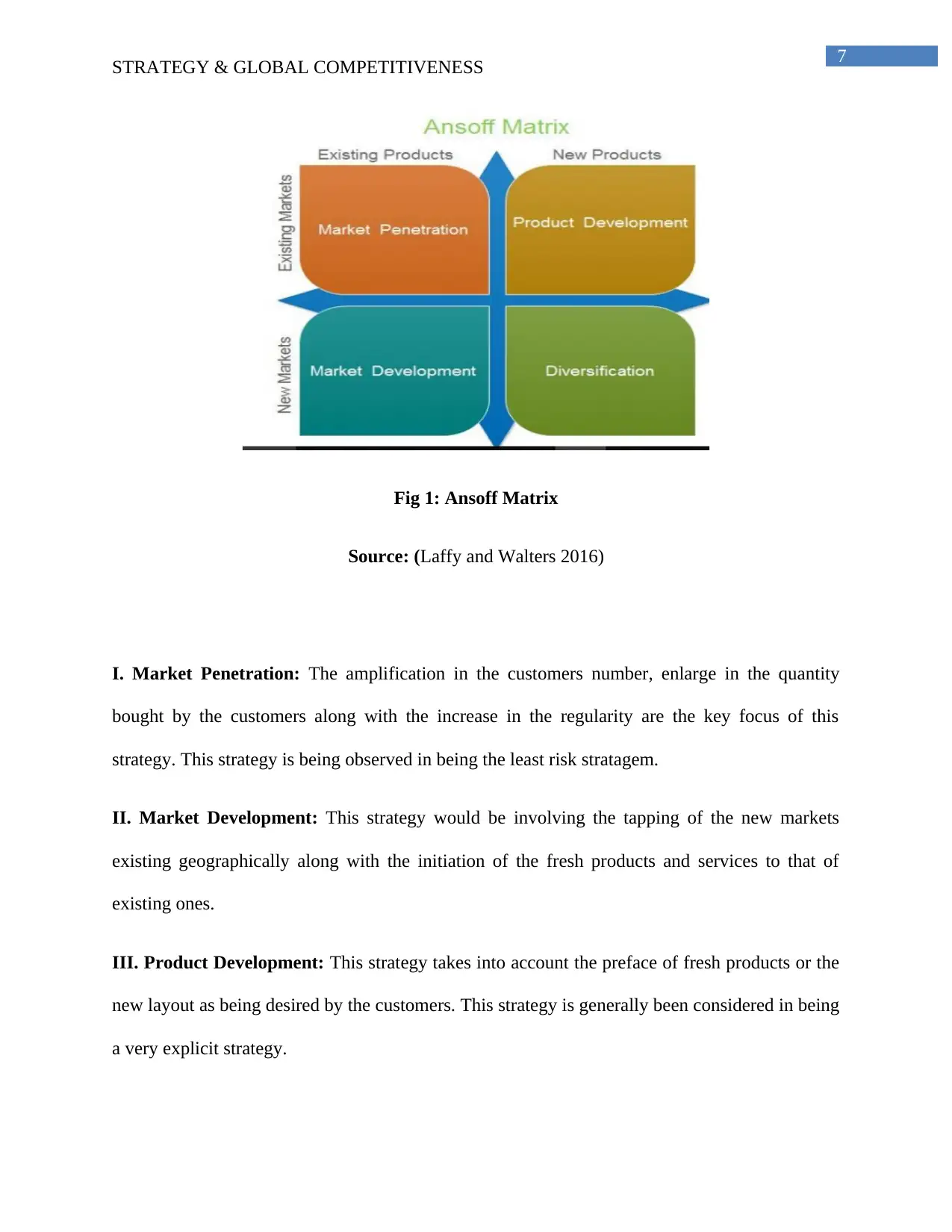
7
STRATEGY & GLOBAL COMPETITIVENESS
Fig 1: Ansoff Matrix
Source: (Laffy and Walters 2016)
I. Market Penetration: The amplification in the customers number, enlarge in the quantity
bought by the customers along with the increase in the regularity are the key focus of this
strategy. This strategy is being observed in being the least risk stratagem.
II. Market Development: This strategy would be involving the tapping of the new markets
existing geographically along with the initiation of the fresh products and services to that of
existing ones.
III. Product Development: This strategy takes into account the preface of fresh products or the
new layout as being desired by the customers. This strategy is generally been considered in being
a very explicit strategy.
STRATEGY & GLOBAL COMPETITIVENESS
Fig 1: Ansoff Matrix
Source: (Laffy and Walters 2016)
I. Market Penetration: The amplification in the customers number, enlarge in the quantity
bought by the customers along with the increase in the regularity are the key focus of this
strategy. This strategy is being observed in being the least risk stratagem.
II. Market Development: This strategy would be involving the tapping of the new markets
existing geographically along with the initiation of the fresh products and services to that of
existing ones.
III. Product Development: This strategy takes into account the preface of fresh products or the
new layout as being desired by the customers. This strategy is generally been considered in being
a very explicit strategy.
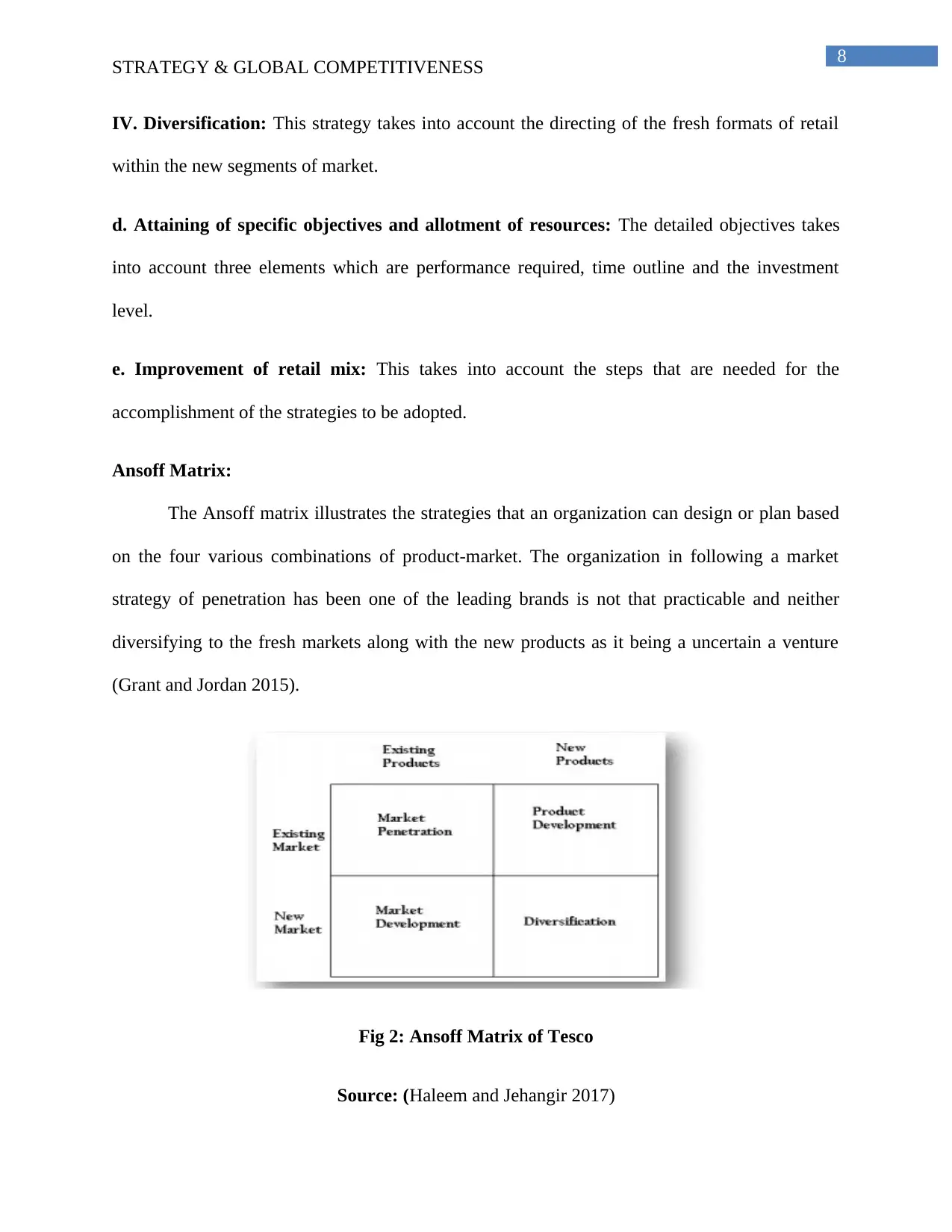
8
STRATEGY & GLOBAL COMPETITIVENESS
IV. Diversification: This strategy takes into account the directing of the fresh formats of retail
within the new segments of market.
d. Attaining of specific objectives and allotment of resources: The detailed objectives takes
into account three elements which are performance required, time outline and the investment
level.
e. Improvement of retail mix: This takes into account the steps that are needed for the
accomplishment of the strategies to be adopted.
Ansoff Matrix:
The Ansoff matrix illustrates the strategies that an organization can design or plan based
on the four various combinations of product-market. The organization in following a market
strategy of penetration has been one of the leading brands is not that practicable and neither
diversifying to the fresh markets along with the new products as it being a uncertain a venture
(Grant and Jordan 2015).
Fig 2: Ansoff Matrix of Tesco
Source: (Haleem and Jehangir 2017)
STRATEGY & GLOBAL COMPETITIVENESS
IV. Diversification: This strategy takes into account the directing of the fresh formats of retail
within the new segments of market.
d. Attaining of specific objectives and allotment of resources: The detailed objectives takes
into account three elements which are performance required, time outline and the investment
level.
e. Improvement of retail mix: This takes into account the steps that are needed for the
accomplishment of the strategies to be adopted.
Ansoff Matrix:
The Ansoff matrix illustrates the strategies that an organization can design or plan based
on the four various combinations of product-market. The organization in following a market
strategy of penetration has been one of the leading brands is not that practicable and neither
diversifying to the fresh markets along with the new products as it being a uncertain a venture
(Grant and Jordan 2015).
Fig 2: Ansoff Matrix of Tesco
Source: (Haleem and Jehangir 2017)
⊘ This is a preview!⊘
Do you want full access?
Subscribe today to unlock all pages.

Trusted by 1+ million students worldwide
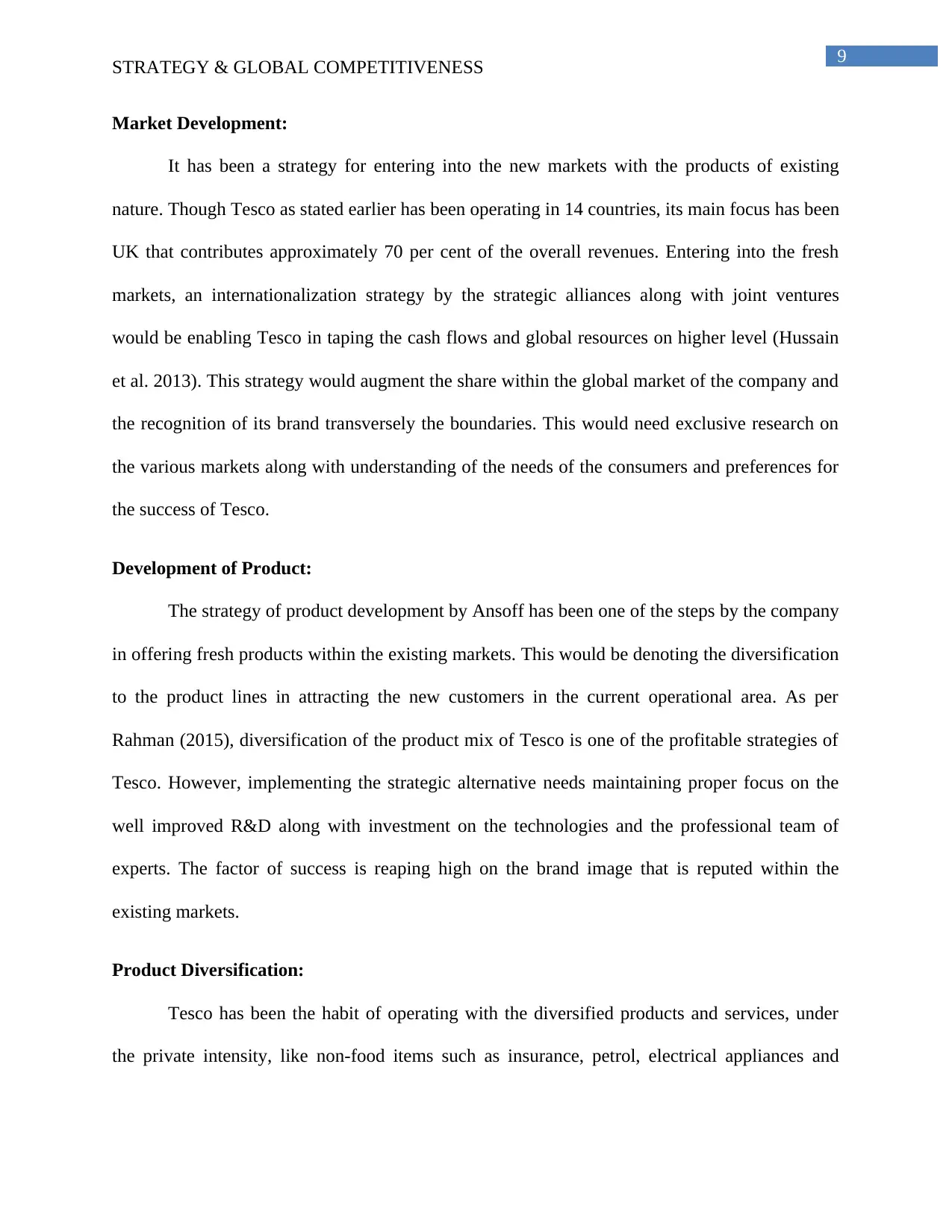
9
STRATEGY & GLOBAL COMPETITIVENESS
Market Development:
It has been a strategy for entering into the new markets with the products of existing
nature. Though Tesco as stated earlier has been operating in 14 countries, its main focus has been
UK that contributes approximately 70 per cent of the overall revenues. Entering into the fresh
markets, an internationalization strategy by the strategic alliances along with joint ventures
would be enabling Tesco in taping the cash flows and global resources on higher level (Hussain
et al. 2013). This strategy would augment the share within the global market of the company and
the recognition of its brand transversely the boundaries. This would need exclusive research on
the various markets along with understanding of the needs of the consumers and preferences for
the success of Tesco.
Development of Product:
The strategy of product development by Ansoff has been one of the steps by the company
in offering fresh products within the existing markets. This would be denoting the diversification
to the product lines in attracting the new customers in the current operational area. As per
Rahman (2015), diversification of the product mix of Tesco is one of the profitable strategies of
Tesco. However, implementing the strategic alternative needs maintaining proper focus on the
well improved R&D along with investment on the technologies and the professional team of
experts. The factor of success is reaping high on the brand image that is reputed within the
existing markets.
Product Diversification:
Tesco has been the habit of operating with the diversified products and services, under
the private intensity, like non-food items such as insurance, petrol, electrical appliances and
STRATEGY & GLOBAL COMPETITIVENESS
Market Development:
It has been a strategy for entering into the new markets with the products of existing
nature. Though Tesco as stated earlier has been operating in 14 countries, its main focus has been
UK that contributes approximately 70 per cent of the overall revenues. Entering into the fresh
markets, an internationalization strategy by the strategic alliances along with joint ventures
would be enabling Tesco in taping the cash flows and global resources on higher level (Hussain
et al. 2013). This strategy would augment the share within the global market of the company and
the recognition of its brand transversely the boundaries. This would need exclusive research on
the various markets along with understanding of the needs of the consumers and preferences for
the success of Tesco.
Development of Product:
The strategy of product development by Ansoff has been one of the steps by the company
in offering fresh products within the existing markets. This would be denoting the diversification
to the product lines in attracting the new customers in the current operational area. As per
Rahman (2015), diversification of the product mix of Tesco is one of the profitable strategies of
Tesco. However, implementing the strategic alternative needs maintaining proper focus on the
well improved R&D along with investment on the technologies and the professional team of
experts. The factor of success is reaping high on the brand image that is reputed within the
existing markets.
Product Diversification:
Tesco has been the habit of operating with the diversified products and services, under
the private intensity, like non-food items such as insurance, petrol, electrical appliances and
Paraphrase This Document
Need a fresh take? Get an instant paraphrase of this document with our AI Paraphraser
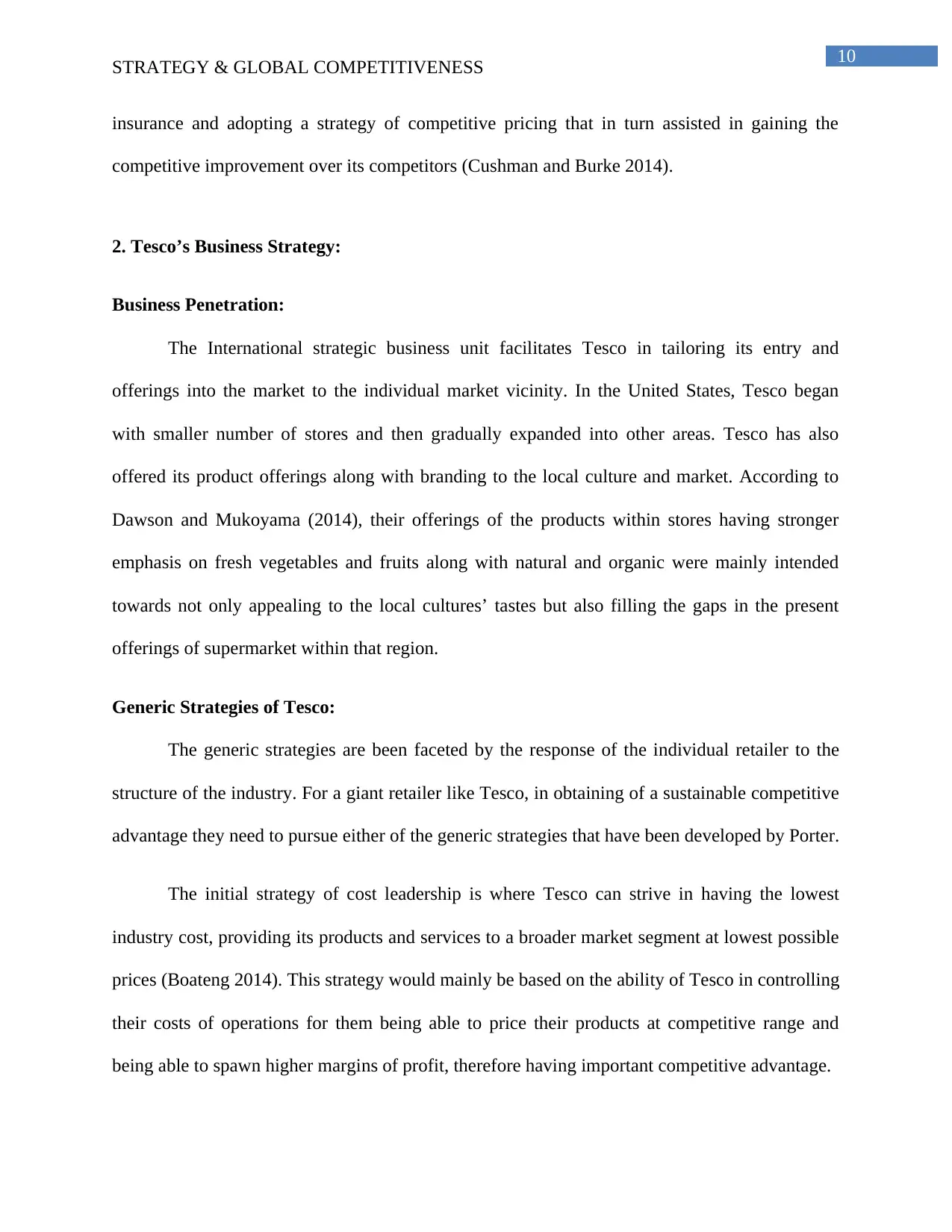
10
STRATEGY & GLOBAL COMPETITIVENESS
insurance and adopting a strategy of competitive pricing that in turn assisted in gaining the
competitive improvement over its competitors (Cushman and Burke 2014).
2. Tesco’s Business Strategy:
Business Penetration:
The International strategic business unit facilitates Tesco in tailoring its entry and
offerings into the market to the individual market vicinity. In the United States, Tesco began
with smaller number of stores and then gradually expanded into other areas. Tesco has also
offered its product offerings along with branding to the local culture and market. According to
Dawson and Mukoyama (2014), their offerings of the products within stores having stronger
emphasis on fresh vegetables and fruits along with natural and organic were mainly intended
towards not only appealing to the local cultures’ tastes but also filling the gaps in the present
offerings of supermarket within that region.
Generic Strategies of Tesco:
The generic strategies are been faceted by the response of the individual retailer to the
structure of the industry. For a giant retailer like Tesco, in obtaining of a sustainable competitive
advantage they need to pursue either of the generic strategies that have been developed by Porter.
The initial strategy of cost leadership is where Tesco can strive in having the lowest
industry cost, providing its products and services to a broader market segment at lowest possible
prices (Boateng 2014). This strategy would mainly be based on the ability of Tesco in controlling
their costs of operations for them being able to price their products at competitive range and
being able to spawn higher margins of profit, therefore having important competitive advantage.
STRATEGY & GLOBAL COMPETITIVENESS
insurance and adopting a strategy of competitive pricing that in turn assisted in gaining the
competitive improvement over its competitors (Cushman and Burke 2014).
2. Tesco’s Business Strategy:
Business Penetration:
The International strategic business unit facilitates Tesco in tailoring its entry and
offerings into the market to the individual market vicinity. In the United States, Tesco began
with smaller number of stores and then gradually expanded into other areas. Tesco has also
offered its product offerings along with branding to the local culture and market. According to
Dawson and Mukoyama (2014), their offerings of the products within stores having stronger
emphasis on fresh vegetables and fruits along with natural and organic were mainly intended
towards not only appealing to the local cultures’ tastes but also filling the gaps in the present
offerings of supermarket within that region.
Generic Strategies of Tesco:
The generic strategies are been faceted by the response of the individual retailer to the
structure of the industry. For a giant retailer like Tesco, in obtaining of a sustainable competitive
advantage they need to pursue either of the generic strategies that have been developed by Porter.
The initial strategy of cost leadership is where Tesco can strive in having the lowest
industry cost, providing its products and services to a broader market segment at lowest possible
prices (Boateng 2014). This strategy would mainly be based on the ability of Tesco in controlling
their costs of operations for them being able to price their products at competitive range and
being able to spawn higher margins of profit, therefore having important competitive advantage.
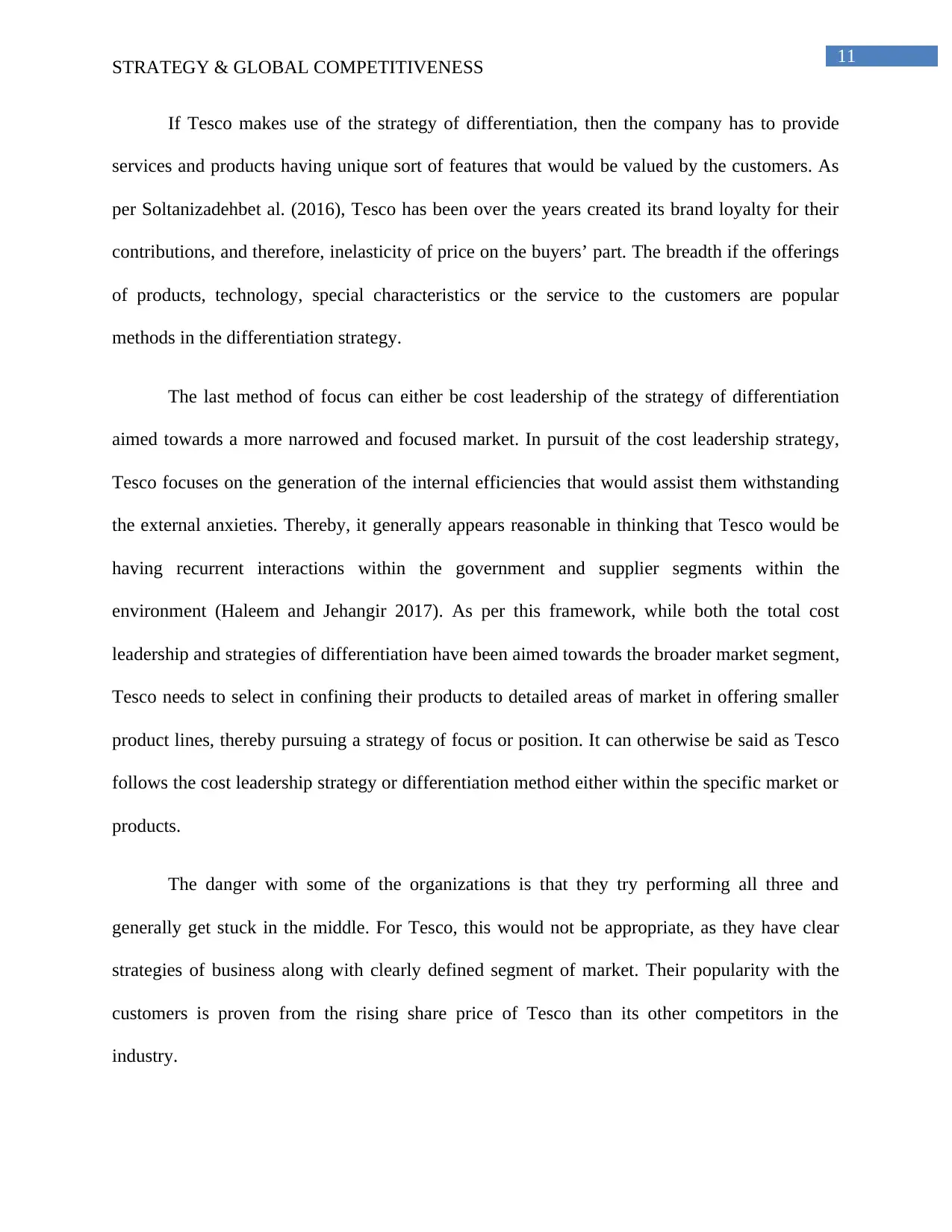
11
STRATEGY & GLOBAL COMPETITIVENESS
If Tesco makes use of the strategy of differentiation, then the company has to provide
services and products having unique sort of features that would be valued by the customers. As
per Soltanizadehbet al. (2016), Tesco has been over the years created its brand loyalty for their
contributions, and therefore, inelasticity of price on the buyers’ part. The breadth if the offerings
of products, technology, special characteristics or the service to the customers are popular
methods in the differentiation strategy.
The last method of focus can either be cost leadership of the strategy of differentiation
aimed towards a more narrowed and focused market. In pursuit of the cost leadership strategy,
Tesco focuses on the generation of the internal efficiencies that would assist them withstanding
the external anxieties. Thereby, it generally appears reasonable in thinking that Tesco would be
having recurrent interactions within the government and supplier segments within the
environment (Haleem and Jehangir 2017). As per this framework, while both the total cost
leadership and strategies of differentiation have been aimed towards the broader market segment,
Tesco needs to select in confining their products to detailed areas of market in offering smaller
product lines, thereby pursuing a strategy of focus or position. It can otherwise be said as Tesco
follows the cost leadership strategy or differentiation method either within the specific market or
products.
The danger with some of the organizations is that they try performing all three and
generally get stuck in the middle. For Tesco, this would not be appropriate, as they have clear
strategies of business along with clearly defined segment of market. Their popularity with the
customers is proven from the rising share price of Tesco than its other competitors in the
industry.
STRATEGY & GLOBAL COMPETITIVENESS
If Tesco makes use of the strategy of differentiation, then the company has to provide
services and products having unique sort of features that would be valued by the customers. As
per Soltanizadehbet al. (2016), Tesco has been over the years created its brand loyalty for their
contributions, and therefore, inelasticity of price on the buyers’ part. The breadth if the offerings
of products, technology, special characteristics or the service to the customers are popular
methods in the differentiation strategy.
The last method of focus can either be cost leadership of the strategy of differentiation
aimed towards a more narrowed and focused market. In pursuit of the cost leadership strategy,
Tesco focuses on the generation of the internal efficiencies that would assist them withstanding
the external anxieties. Thereby, it generally appears reasonable in thinking that Tesco would be
having recurrent interactions within the government and supplier segments within the
environment (Haleem and Jehangir 2017). As per this framework, while both the total cost
leadership and strategies of differentiation have been aimed towards the broader market segment,
Tesco needs to select in confining their products to detailed areas of market in offering smaller
product lines, thereby pursuing a strategy of focus or position. It can otherwise be said as Tesco
follows the cost leadership strategy or differentiation method either within the specific market or
products.
The danger with some of the organizations is that they try performing all three and
generally get stuck in the middle. For Tesco, this would not be appropriate, as they have clear
strategies of business along with clearly defined segment of market. Their popularity with the
customers is proven from the rising share price of Tesco than its other competitors in the
industry.
⊘ This is a preview!⊘
Do you want full access?
Subscribe today to unlock all pages.

Trusted by 1+ million students worldwide
1 out of 24
Related Documents
Your All-in-One AI-Powered Toolkit for Academic Success.
+13062052269
info@desklib.com
Available 24*7 on WhatsApp / Email
![[object Object]](/_next/static/media/star-bottom.7253800d.svg)
Unlock your academic potential
Copyright © 2020–2025 A2Z Services. All Rights Reserved. Developed and managed by ZUCOL.





